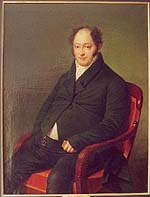
click on picture to enlarge |
The
book is titled „Beziehungen Goethes zu Hamburg“
(Goethe's relationship with Hamburg), written by Johannes Kießner
in 1912, senior teacher at a secondary girls' school in Hamburg. It is
well known, and is confirmed by the author, that Johann Wolfgang von
Goethe has never visited Hamburg. What an omission! However, the Prince
of Letters indulged in a few days of recreation in the Fichtelgebirge
mountains, close to the Bohemian border. There one met with other
vacationers, among them the painters Mosnier, Waagen, and Kaaz, as well
as one Mr Silm from Hamburg whom the author thought to be an artist of
the brush, too. However, during the 500 years of family history there
was only one painter, and he lived in England in the 19th century. But
we have an inkling who this gentleman was. But let's hear first what
Goethe had to say.
On the 25th of August, 1808 "I
crossed the bridge over the Eger and took a footpath to Fischern where
I met Kaaz together with one Mr Silm from Hamburg and Stoll the Elder
from Dresden, and conversed especially with Silm who walks a lot for
fear of becoming portly."
If you have looked already at the History page of our Web site and
learned a few things about Jerôme Sillem under the heading "A
great banker" you may be interested to know that the couple owned,
besides its city mansion, an estate in the countryside. One Karl
Friedrich Zelter who headed a Singing Academy in Berlin that was
well-reputed at the time, informed his friend Goethe 15 years
afterwards of a journey to the Netherlands, and wrote, among other
things, the following:
"... I had hardly arrived
in Amsterdam when I sat at the dining table at the side of one Mr
Sillem, a partner in Hope ... As you are not unfamiliar with the
(banking) house of Hope and Compagnie ... you will understand that this
is the first night in Holland where I did not freeze to death. My Mr
Sillem is a man of fifty-five. An able walker. Our first job yesterday
... was a promenade on the dunes of the North Sea..."
As for "becoming portly", the portrait of Jerôme Sillem
tells us that his enthusiastic walking did not achieve its proclaimed
aim.
|
|


